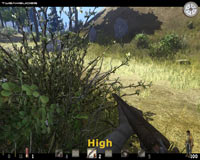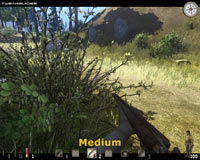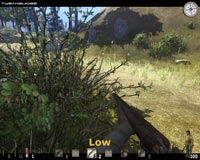Call of Juarez Tweak Guide
[Page 7] In-Game Settings (Pt.3)
Foliage Quality: This setting purports to control the level of detail of the foliage - namely the trees, bushes and grass in outdoor areas. The available options are Low, Medium, High. A screenshot comparison of the three levels is provided above, however note that the only noticeable difference is that the grass becomes thinned out at lower levels. There is no apparent impact on the quality or quantity of bushes or trees from what I have observed throughout a range of areas. However because grass can increase polygon counts and hence can impact on performance, lowering foliage quality allows you to improve FPS slightly without any major impact on visual quality.
Enhanced Quality: This option is only available to be switched on if you're running in SM4.0 (DirectX10) mode - see page 4 for more details. When enabled under DirectX10, it adds new materials, relief mapping, more accurate bump mapping, and specular and soft-edged foliage. High Dynamic Range-correct multisample Anti-Aliasing is also used in DX10 mode. Once again, to see image quality comparisons between DX9 and DX10, see the bottom of page 4. Enabling DX10 mode will decrease performance, depending on the scene, but it is subjective as to whether you consider the change in visuals worth the performance drop.
Audio
Sound Quality: This setting determines the general clarity of sounds in the game. The available options are Low, Medium, and High. The difference between High and Medium is not significant, but the drop to Low is noticeable, as the sound goes from 44Khz to 22KHz sample rate. Lowering the sound quality can improve performance, but the FPS difference is not significant unless you're using an old sound card or onboard audio solution, so it's generally recommended that you keep a Medium or High Sound Quality.
Music, SFX, Speech Volume: These sliders control the Music, Special Effects and Speech volume levels. The further to the right the slider, the louder each audio component will be. However setting the sliders to the far left does not remove sounds from memory and hence the volume levels have no performance impact - set to suit your tastes.
Hardware Mixing: When set to On, the game will use your audio hardware to reproduce audio. This provides the best performance and sound quality on most systems. You should only set this to Off for troubleshooting purposes, or if you run a low-end onboard audio solution.
EAX: If you have an EAX (Environmental Audio)-capable sound card, such as an Audigy or X-Fi series card, you can tick this option to provide more realistic 3D sound positioning and better sound effects in CoJ. However EAX can reduce performance, and can also cause audio glitches. You should make sure that you have the latest sound drivers installed for your sound card, but if you're still having sound issues, untick this option and see further below for some other things you can try. For most people with decent sound cards, enabling EAX should be fine, and the increased 3D audio quality is usually worth it, as the performance hit is minor. Note that in Vista, for EAX to work, you will need to choose the OpenAL Sound API (See below).
Force Software EAX: This option only appears to be available if you have the OpenAL API selected (See below). When enabled, this option allows a more compatible form of EAX which can work better with non-Creative sound cards. However software EAX uses your CPU to process these effects and hence can use up more resource and result in reduced FPS, so it is generally not recommended.
Sound API: This option allows you to tell Call of Juarez to use either the Direct3D or OpenAL sound systems. Direct3D provides maximum compatibility and generally good quality and performance in Windows XP. However if you're running Call of Juarez under Windows Vista, to get full hardware acceleration it is recommended that you select the OpenAL API instead. If you experience problems with the audio in Call of Juarez, make sure that you've installed the latest sound drivers for your sound card, as this can make a significant difference. If necessary, uninstall all existing sound drivers, reboot, then install the latest driver again. Make sure that your sound settings and speaker configuration are correctly selected under the Windows Control Panel>Sounds and Audio Devices. Finally, disable EAX if you still experience sound glitches, and try turning Hardware Mixing Off. See the Advanced Tweaking section for more details of how you can manually adjust certain sound parameters to further customize or troubleshoot sound issues.
Controls
This section has a range of player control options you can change. To change the key or mouse button bound to a particular control, simply click on the box next to the control you wish to change, then press the new key/mouse button to bind it. Go through all these settings and set the controls according to your taste, none of them have any performance impacts.
Invert Mouse: If set to Off, moving your mouse back makes your character look down, moving your mouse forward makes him look up. If set to On, the opposite happens. Has no impact on performance, so set to suit your taste.
Mouse Sensitivity: This slider controls how sensitive the mouse is in the game. The further right the slider (the more boxes are highlighted), the more sensitive your mouse will be to movements while playing. Note however that mouse lag - that is, the slowing down and general 'lagginess' of you mouse or crosshair while playing the game is not affected by this setting. Mouse lag is usually caused by very low FPS in certain areas, so firstly measure your FPS (See the Conclusion section) and if it is very low you should consider reducing some of your settings to increase your average framerate. There are also details of the commonly-recommended 'Max Frames to Render Ahead' tweak on the last page of this guide which you should read.
Game
None of the settings below have any impact on performance, so set to suit your taste.
Auto Reload Weapons: If set to On, as soon as your weapon(s) run out of ammo, your character will begin reloading them the next time you click the fire button. For weapons with multiple shots like six-shooters, if at any time during reloading you wish to fire the weapon, click the fire button and your character will cease loading and immediately fire using the number of bullets already loaded.
Full Akimbo: When this option is set to On, your left and right hands are independent of each other. This means for example that when holding a pistol in each hand, if you run out of bullets in your left gun, clicking the left mouse button will reload that gun. However, if you set this option to Off, if one of your guns runs out of bullets, clicking the mouse button for that gun will fire the gun in the other hand until it too runs dry. Whether you enable this option or not is up to you, it all depends on your particular gameplay style.
Speech Language: The default for this option is English. However if you wish to select a different language for the spoken voices in the game, set this option to your chosen language. Usually you will only see one option here if you're using the English version of the game.
Subtitles: If you want all the main spoken dialog to be subtitled, set this option to On. Not all spoken words will have subtitles, but the main dialogs will.
That covers the In-Game Settings. The next section looks at some Advanced Tweaks for Call of Juarez.



